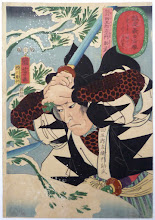Alexis has got me thinking. Probably not as deeply or as meaningfully as he'd like (he's got rather high standards, and I'm too busy with earning both incomes in my two income family to hold myself to such high standards in my leisure activities), but he did get me thinking.
So D&D (OD&D, Classic D&D, AD&D), as you all know, comes with both Dungeon and Wilderness Random Encounter tables.
Now, those Wilderness Encounter tables include chances to meet everything from a few wild deer to ancient red dragons as you wander from place to place. And as Alexis points out, by using them as written, how could a merchant caravan ever get from one city to another without being pillaged by 6-60 orcs, a small troupe of frost giants, or a wing of griffons?
But let's take a look at what the charts really are. They're tables for things you might meet in the wilderness, not just while taking a stroll through Farmer Maggot's cornfield.
In the Dominion system in Frank Mentzer's Companion Set, he divides up areas into Civilized, Borderland, and Wilderness. I get a feeling (just a feeling, I've got nothing to back this up quote-wise) that he may have gotten this from Gary (Keep on the Borderland being the artifact that makes me think this).
If this was the intention of the game's creators, we can assume that any game setting should have areas on the world map that are 'wilderness' and areas that are not.
If we divide up any map into Civilized, Borderland, and Wilderness areas [mapping to the alignments of Law--Neutrality--Chaos, interestingly] we'd have Civilized areas where you're likely not going to run into anything besides human-types and normal animals. Merchants, pilgrims, soldiers, wandering minstrels, peasants, etc. Very similar to town/city encounter charts.
In Borderlands, things are getting a bit more wild. There will be more monsters, demi-humans, and giant animals encountered, but still plenty of human-types. And most likely there won't be many overpoweringly difficult monsters.
In the Wilderness--the true wilderness--anything goes. Human-types will become scarce, and those that do appear will most likely be other adventuring types or 'monster' humans like bandits, brigands, pirates, etc.
But what about those merchants that need to travel through the Wilds to get from Port Gunthar to Oxcross? Well, that's what roads are for. Or charted rivers. Or established sea lanes. A well-patrolled and maintained road would count as at worst Borderland, and may be considered Civilized all along its length.
The benefits? Well, first, you've got a bit of verisimilitude in that unlike early CRPGs, your characters aren't the only non-monsters outside of towns. There's also both in-game and meta-game reasons why monsters aren't eating every commoner who tries to go on a little trip.
Second, it provides players with a way to judge their risk/reward, similar to dungeon levels.
Third, it makes decision points on the map. Do we take the long King's Road to Oxcross, or try to save two day's travel by cutting through the Haunted Woods?
Fourth, it reinforces the feeling of Law vs. Chaos as trying to tame the wilderness/wreck civilization, rather than just pseudonyms for good and evil.
Traveller Distinctives: Speculative Trade
4 hours ago





I've taken a similar approach. Like many, I roll for encounters by terrain type and have a type for "settled" which typically means good bottom land where agriculture and therefore communities thrive. Farmer Maggot's fields, in other words. I also have different tables for traveling main trade routes vs. back-roads. Differentiating more broadly between "civilized" and "border" areas isn't something I've done though, though, but it makes sense. Thanks.
ReplyDeleteWhy didn't you post this before I drew up my wilderness map? Now I have to start over!
ReplyDeleteThat's a weird way of saying that this idea is brilliant.
Yes, quite succinctly brilliant! This will forever change the way I handle wilderness maps.
ReplyDeleteAs support for your position, I'd like to point out that the implication in OD&D is that you only roll for random wilderness encounters in untamed lands, i.e., those without an active stronghold. Building a stronghold involves clearing a 20-mile zone of monsters, so any encounters in those areas are either a patrol from the stronghold or a special "civilized" list with results like merchants, loggers, trappers, or the like transporting materials one direction or the other.
ReplyDeleteGood stuff--I've done this a lot in my own games. In addition, you should also note that travel time on roads usually results in towns or inns being within a days' travel of one-another in most campaign settings.
ReplyDeleteIt depends on what you're playing. In the very early medieval period (700-1066 I'd say, still the Dark Ages, although historians hate that term), it wasn't uncommon to have a lot of unsettled lands and wilderness. The fall of the Roman Empire left huge swathes of territory depopulated. Communication shrank a great deal, and trade slowed tremendously (but it didn't halt). Banditry is more commonplace during different time periods, and overland travel was never totally safe until perhaps the modern era (and still isn't in some parts).
Also, consider having encounter tables for settled areas that are relatively benign and extremely commonplace. Traveling minstrels, peddlers, farmers going to market, a mounted patrol, pilgrims, etc. aren't going to be rare in the more "civilized" areas. You should actually have a lot of encounters in these sorts of places, and far more often than in the wilderness or borderlands, if you think about it.